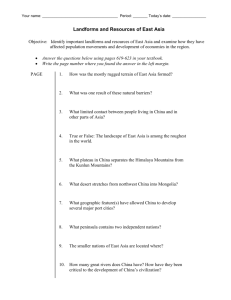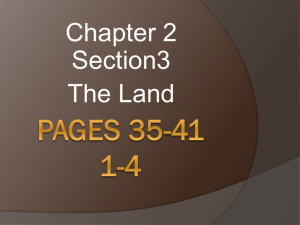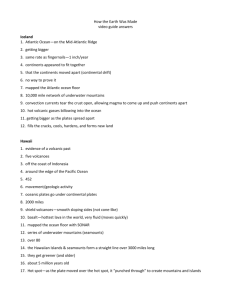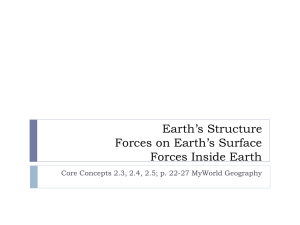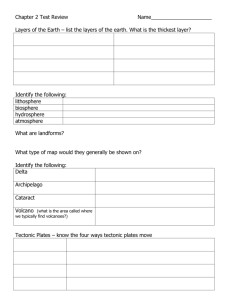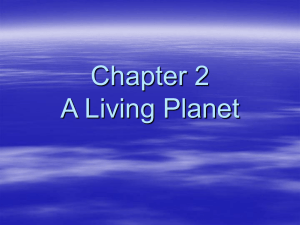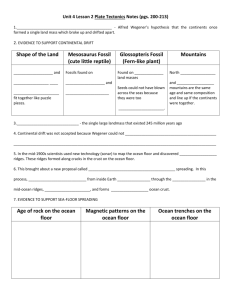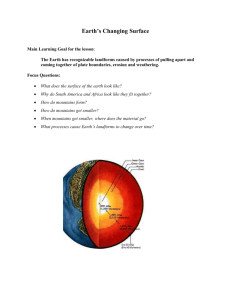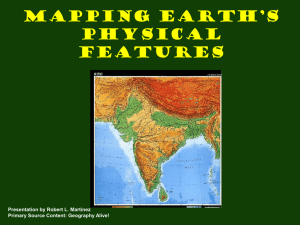World Geography Ch. 1-3 Test Review
advertisement
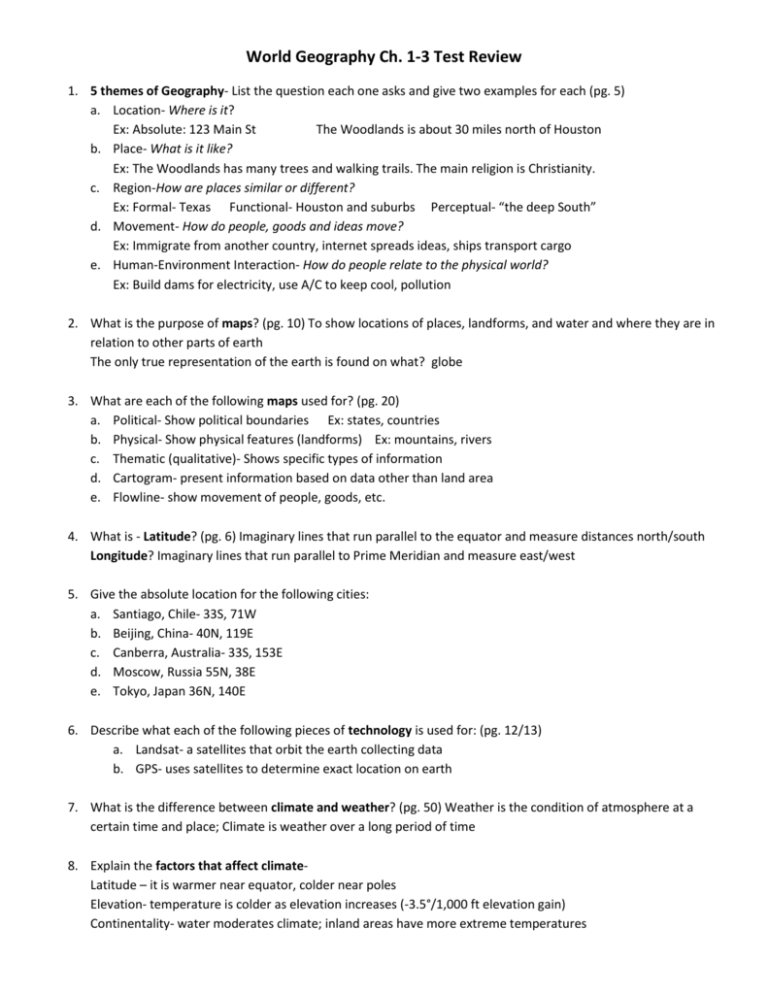
World Geography Ch. 1-3 Test Review 1. 5 themes of Geography- List the question each one asks and give two examples for each (pg. 5) a. Location- Where is it? Ex: Absolute: 123 Main St The Woodlands is about 30 miles north of Houston b. Place- What is it like? Ex: The Woodlands has many trees and walking trails. The main religion is Christianity. c. Region-How are places similar or different? Ex: Formal- Texas Functional- Houston and suburbs Perceptual- “the deep South” d. Movement- How do people, goods and ideas move? Ex: Immigrate from another country, internet spreads ideas, ships transport cargo e. Human-Environment Interaction- How do people relate to the physical world? Ex: Build dams for electricity, use A/C to keep cool, pollution 2. What is the purpose of maps? (pg. 10) To show locations of places, landforms, and water and where they are in relation to other parts of earth The only true representation of the earth is found on what? globe 3. What are each of the following maps used for? (pg. 20) a. Political- Show political boundaries Ex: states, countries b. Physical- Show physical features (landforms) Ex: mountains, rivers c. Thematic (qualitative)- Shows specific types of information d. Cartogram- present information based on data other than land area e. Flowline- show movement of people, goods, etc. 4. What is - Latitude? (pg. 6) Imaginary lines that run parallel to the equator and measure distances north/south Longitude? Imaginary lines that run parallel to Prime Meridian and measure east/west 5. Give the absolute location for the following cities: a. Santiago, Chile- 33S, 71W b. Beijing, China- 40N, 119E c. Canberra, Australia- 33S, 153E d. Moscow, Russia 55N, 38E e. Tokyo, Japan 36N, 140E 6. Describe what each of the following pieces of technology is used for: (pg. 12/13) a. Landsat- a satellites that orbit the earth collecting data b. GPS- uses satellites to determine exact location on earth 7. What is the difference between climate and weather? (pg. 50) Weather is the condition of atmosphere at a certain time and place; Climate is weather over a long period of time 8. Explain the factors that affect climateLatitude – it is warmer near equator, colder near poles Elevation- temperature is colder as elevation increases (-3.5°/1,000 ft elevation gain) Continentality- water moderates climate; inland areas have more extreme temperatures Landforms such as mountains block moisture (Rain shadow effect) Ocean Currents and winds- Cold and warm ocean currents circulate, same as the winds 9. Explain the hydrologic cycle. (pg. 32/50) Circulation of water between atmosphere, oceans and earth; Water evaporates, condenses and then falls to earth as precipitation 10. What three parts make up the biosphere? (pg. 28) Lithosphere, atmosphere, hydrosphere 11. What is El Nino? Warming of the Pacific that brings increased rainfall to the Americas La Nina? Warming of the Pacific that brings increased rainfall to Asia 12. What two things give the earth its different seasons? (pg. 49) Tilt of the earth and revolution around sun 13. Explain the difference between hurricanes and tornadoes. (pg. 51)Hurricanes form over warm ocean water and bring destructive wind and rain; Tornadoes are powerful wind funnels that are born of strong thunderstorms 14. Define ecosystem. (pg. 65) interdependent community of plants and animals. 15. Describe the following climate zones- (60) a. Highlands- rugged mountain areas b. Desert-receive less than 10 inches of rain per year c. Tropical wet- hot with an average rainfall of more than 80 inches/yr (rainforests) d. Tundra- flat, treeless lands forming a ring around Arctic Ocean; permanently frozen e. Mediterranean- hot and dry summers, cool and rainy winters; rich agriculture 16. What is continental drift? (29) The process of tectonic plates shifting and causing continents to move; earth was once a supercontinent called Pangea 17. What are the three types of plate boundaries and how do they move? (38) -Convergent- plates collide -Divergent- plates move apart -Transform- plates slide past one another 18. What happens at the plate junctions/boundaries? Mountains/faults are formed, earthquakes, volcanoes 19. What are some examples of external forces that shape the earth? (42)Weathering, erosion, glaciation Explain the two types of weathering: -Chemical- changes the composition of the rock -Mechanical- breaks down the rock into pieces 20. What is the general makeup of soil? (45) Rock, organic matter (humus), air, water 21. Why are fossil fuels harmful? Cause pollution 22. What two things does a climograph show? Temperature (line) and precipitation (bars)
